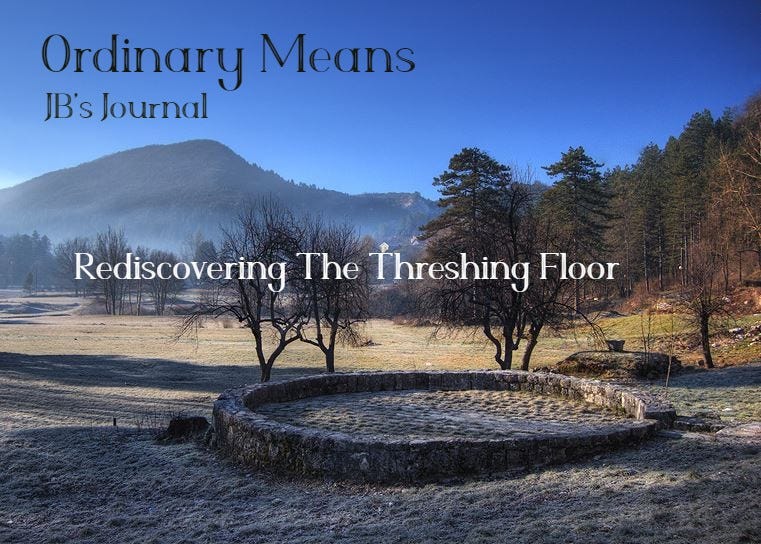I wrote to someone close to me this week, I said, “I am on the threshing floor again,” I used the image to express that emotional place of dependance on the Lord, and sensing His hand of providence again - to make me more like Him.
I suppose an earthier phrase would be - embrace the suck.
In ancient times, the threshing floor held immense significance in agricultural communities, particularly in regions where grains like wheat, barley, and oats were cultivated. The threshing floor was not just a physical space but a central hub for the harvest process, crucial for separating the edible grain from the inedible chaff.
Size and Location:
Threshing floors varied in size depending on the community's needs and the scale of agriculture. They were often large, open-air spaces located on elevated ground or hillsides to catch the wind. This positioning was strategic, as the wind played a vital role in the threshing process.
Construction:
Threshing floors were typically circular or rectangular in shape, bordered by low stone walls or sometimes simply outlined by rocks. The floor itself was often compacted dirt or stone, designed to provide a solid surface for the threshing process. Some larger threshing floors could be as wide as 50 to 100 feet in diameter, accommodating multiple workers and animals.
The ancient threshing floor was a vital and symbolic space where the hard work of harvest took place. Its size, location, and purpose were all carefully considered to ensure efficient grain separation.
Use and Function:
The primary purpose of the threshing floor was to separate the grain from the chaff, which is the husk or outer casing of the grain. After the harvest, the sheaves of wheat or barley were brought to the threshing floor, where the process of threshing took place. Beyond its practical use, the threshing floor held deep cultural, spiritual, and biblical significance as a place of provision, blessings, and divine encounter.
Threshing Process:
Arrangement of Sheaves: Workers would lay out the sheaves of harvested grain across the threshing floor, creating a layer of stalks and heads of grain.
Trampling with Animals: Oxen or other livestock were often used to trample the grain. They would be led in a circular motion around the threshing floor, either pulling a threshing sledge or simply walking over the grain. This trampling action would break the grain kernels free from the stalks.
Winnowing: After the threshing, the mixture of grain and chaff would be tossed into the air using a winnowing fork or shovel. The lighter chaff, being less dense, would be blown away by the wind, while the heavier grain kernels would fall back to the threshing floor.
Purpose and Significance:
The threshing floor was not just a utilitarian space but held deep cultural and spiritual significance in ancient agricultural societies:
Practical Importance: The threshing floor was essential for producing the staple grains that sustained communities. It was a place of labor and productivity, where the hard work of harvest was carried out.
Symbolism of Harvest: Beyond its practical use, the threshing floor symbolized abundance, provision, and the rewards of hard work. A bountiful harvest on the threshing floor was a cause for celebration and gratitude.
Spiritual Significance: In biblical times, the threshing floor was often associated with divine blessings and judgment. It was where God's provision was manifested, and where His people sought His favor. In some cases, it was also a site for sacred rituals or offerings.
Biblical References: Numerous passages in the Bible reference the threshing floor, highlighting its significance in ancient Israel:
Ruth and Boaz: The book of Ruth depicts Ruth gleaning in the fields and later meeting Boaz at the threshing floor, where he extends kindness and protection to her.
David's Purchase: King David famously purchased the threshing floor of Araunah the Jebusite to build an altar to the Lord, marking it as a sacred site (2 Samuel 24).
Prophetic Imagery: Prophetic passages often use the threshing floor as a metaphor for judgment, purification, or divine intervention (Isaiah 21:10, Micah 4:12-13).
Keep reading with a 7-day free trial
Subscribe to Ordinary Means by Jonny Bennett to keep reading this post and get 7 days of free access to the full post archives.



